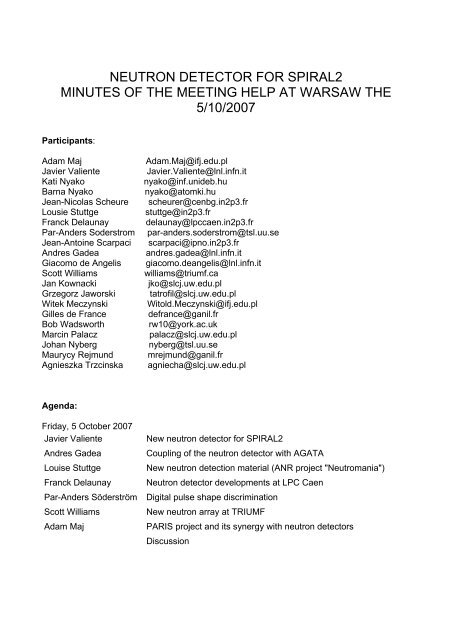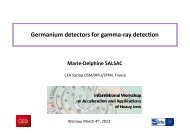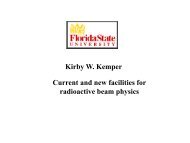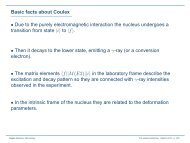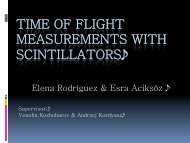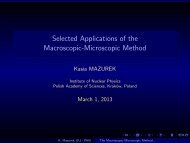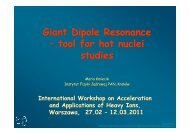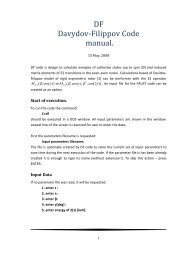neutron detector for spiral2 minutes of the meeting help at warsaw ...
neutron detector for spiral2 minutes of the meeting help at warsaw ...
neutron detector for spiral2 minutes of the meeting help at warsaw ...
Create successful ePaper yourself
Turn your PDF publications into a flip-book with our unique Google optimized e-Paper software.
NEUTRON DETECTOR FOR SPIRAL2<br />
MINUTES OF THE MEETING HELP AT WARSAW THE<br />
5/10/2007<br />
Participants:<br />
Adam Maj<br />
Javier Valiente<br />
K<strong>at</strong>i Nyako<br />
Barna Nyako<br />
Jean-Nicolas Scheure<br />
Lousie Stuttge<br />
Franck Delaunay<br />
Par-Anders Soderstrom<br />
Jean-Antoine Scarpaci<br />
Andres Gadea<br />
Giacomo de Angelis<br />
Scott Williams<br />
Jan Kownacki<br />
Grzegorz Jaworski<br />
Witek Meczynski<br />
Gilles de France<br />
Bob Wadsworth<br />
Marcin Palacz<br />
Johan Nyberg<br />
Maurycy Rejmund<br />
Agnieszka Trzcinska<br />
Adam.Maj@ifj.edu.pl<br />
Javier.Valiente@lnl.infn.it<br />
nyako@inf.unideb.hu<br />
nyako@<strong>at</strong>omki.hu<br />
scheurer@cenbg.in2p3.fr<br />
stuttge@in2p3.fr<br />
delaunay@lpccaen.in2p3.fr<br />
par-anders.soderstrom@tsl.uu.se<br />
scarpaci@ipno.in2p3.fr<br />
andres.gadea@lnl.infn.it<br />
giacomo.deangelis@lnl.infn.it<br />
williams@triumf.ca<br />
jko@slcj.uw.edu.pl<br />
t<strong>at</strong>r<strong>of</strong>il@slcj.uw.edu.pl<br />
Witold.Meczynski@ifj.edu.pl<br />
defrance@ganil.fr<br />
rw10@york.ac.uk<br />
palacz@slcj.uw.edu.pl<br />
nyberg@tsl.uu.se<br />
mrejmund@ganil.fr<br />
agniecha@slcj.uw.edu.pl<br />
Agenda:<br />
Friday, 5 October 2007<br />
Javier Valiente New <strong>neutron</strong> <strong>detector</strong> <strong>for</strong> SPIRAL2<br />
Andres Gadea<br />
Coupling <strong>of</strong> <strong>the</strong> <strong>neutron</strong> <strong>detector</strong> with AGATA<br />
Louise Stuttge<br />
New <strong>neutron</strong> detection m<strong>at</strong>erial (ANR project "Neutromania")<br />
Franck Delaunay Neutron <strong>detector</strong> developments <strong>at</strong> LPC Caen<br />
Par-Anders Söderström Digital pulse shape discrimin<strong>at</strong>ion<br />
Scott Williams<br />
New <strong>neutron</strong> array <strong>at</strong> TRIUMF<br />
Adam Maj<br />
PARIS project and its synergy with <strong>neutron</strong> <strong>detector</strong>s<br />
Discussion
The goal <strong>of</strong> <strong>the</strong> <strong>meeting</strong> was to ga<strong>the</strong>r researchers interested in building up a future <strong>neutron</strong><br />
<strong>detector</strong> <strong>for</strong> SPIRAL2.<br />
The <strong>meeting</strong> started with a present<strong>at</strong>ion <strong>of</strong> <strong>the</strong> “FP7 – INFRASTRUCTURES-2007-1”<br />
SPIRAL2 Prepar<strong>at</strong>ory Phase where <strong>the</strong> task 5.8 (Neutron Wall) within <strong>the</strong> WP5<br />
(Instrument<strong>at</strong>ion Spiral2) was described. The objectives <strong>of</strong> <strong>the</strong> task 5.8 is to build an ancillary<br />
<strong>neutron</strong> <strong>detector</strong> <strong>for</strong> AGATA and EXOGAM2 germanium array installed <strong>at</strong> <strong>the</strong> intense<br />
stable and radioactive ion beams from SPIRAL2. The Neutron Detector should be<br />
characterized by <strong>the</strong> highest possible <strong>neutron</strong> detection efficiency, excellent discrimin<strong>at</strong>ion <strong>of</strong><br />
<strong>neutron</strong>s and gamma rays, and a very small <strong>neutron</strong>-sc<strong>at</strong>tering probability. These properties<br />
are necessary in order to achieve a clean and efficient identific<strong>at</strong>ion <strong>of</strong> gamma rays from <strong>the</strong><br />
rare <strong>neutron</strong>-deficient nuclides produced in reactions in which only two or more <strong>neutron</strong>s are<br />
emitted.<br />
It was emphasize th<strong>at</strong> in three years time <strong>the</strong>re should be ready a MoU (Memorandum <strong>of</strong><br />
Understanding) where <strong>the</strong> future <strong>neutron</strong> array is defined in detail.<br />
Andres Gadea (Coupling <strong>of</strong> <strong>the</strong> <strong>neutron</strong> <strong>detector</strong> with AGATA)<br />
The Advanced GAmma-ray Tracking Array, AGATA, is proposed <strong>for</strong> high-resolution γ-ray<br />
spectroscopy with exotic beams. AGATA will employ highly segmented Ge <strong>detector</strong>s as well<br />
as fully digital electronics and relies on newly developed pulse-shape analysis and tracking<br />
methods. The structure <strong>of</strong> <strong>the</strong> AGATA d<strong>at</strong>a processing with an ancillary <strong>detector</strong> is done using<br />
an interface to <strong>the</strong> GTS (Global Trigger system) via a mezzanine. The d<strong>at</strong>a from AGATA and<br />
<strong>the</strong> ancillary <strong>detector</strong>, which is time-stamped, is merged into an event builder. There is a<br />
prompt local trigger available from digitizers.<br />
Any ancillary <strong>detector</strong> can make part <strong>of</strong> <strong>the</strong> AGATA trigger, but in th<strong>at</strong> case <strong>the</strong> system should<br />
be able to support a large l<strong>at</strong>ency time (6 microseconds). In this case it is required<br />
preprocessing <strong>of</strong> <strong>the</strong> signals. It was suggested a fully digital system, with an analog/digital<br />
buffering.<br />
Louise Stuttgé (New <strong>neutron</strong> detection m<strong>at</strong>erial (ANR project "Neutromania"))<br />
A collabor<strong>at</strong>ion issued from <strong>the</strong> DEMON collabor<strong>at</strong>ion has been working <strong>for</strong> about two years<br />
on a project which aims to develop a new m<strong>at</strong>erial <strong>for</strong> <strong>the</strong> <strong>neutron</strong> detection. This work which<br />
is done in <strong>the</strong> frame <strong>of</strong> <strong>the</strong> French ANR-programme, associ<strong>at</strong>es physicists and chemists from<br />
Strasbourg, Caen and Saclay. The goal <strong>of</strong> <strong>the</strong> project is to obtain a solid scintill<strong>at</strong>or which<br />
presents <strong>at</strong> least <strong>the</strong> same good characteristics as <strong>the</strong> organic liquid scintill<strong>at</strong>or (NE213) used<br />
in <strong>the</strong> DEMON <strong>detector</strong> (g-<strong>neutron</strong> discrimin<strong>at</strong>ion, time resolution, efficiency,…). This new<br />
m<strong>at</strong>erial could in particular be used in <strong>the</strong> construction <strong>of</strong> a new <strong>neutron</strong> <strong>detector</strong> <strong>for</strong><br />
SPIRAL2.<br />
Indeed it seems important to think about such a new m<strong>at</strong>erial as with <strong>the</strong> evolution <strong>of</strong> <strong>the</strong><br />
security regul<strong>at</strong>ion, it will become more and more difficult to use liquid scintill<strong>at</strong>ors <strong>at</strong> places<br />
like SPIRAL2 as <strong>the</strong>y present all major inconvenience: <strong>the</strong> NE213 is toxic, corrosive,<br />
flammable, explosive and dangerous <strong>for</strong> <strong>the</strong> environment. No development has been<br />
per<strong>for</strong>med in this detection field since <strong>the</strong> 1970s. Moreover <strong>the</strong> process which allows <strong>the</strong> g-
<strong>neutron</strong> discrimin<strong>at</strong>ion, <strong>the</strong> fluorescence, is not well understood.<br />
First results look promising although a lot <strong>of</strong> work has to be done be<strong>for</strong>e it can be claimed th<strong>at</strong><br />
<strong>the</strong> project succeeded. One more year may be enough to produce a prototype <strong>of</strong> such a<br />
<strong>detector</strong>.<br />
Concerning <strong>the</strong> demand <strong>of</strong> such a m<strong>at</strong>erial, <strong>the</strong> Fazia collabor<strong>at</strong>ion wants to use <strong>the</strong>se solid<br />
<strong>detector</strong>s in vacuum <strong>for</strong> two purposes: <strong>neutron</strong> detection and energy measurement <strong>of</strong> light<br />
charged particles. The CORSET-DEMON collabor<strong>at</strong>ion has been investig<strong>at</strong>ing <strong>the</strong> capture<br />
dynamics <strong>at</strong> low energy in <strong>the</strong> heavy and superheavy mass region <strong>for</strong> many years. Both<br />
SPIRAL2 and DRIBS2 (Dubna) will allow to extend this investig<strong>at</strong>ion to <strong>neutron</strong> rich systems.<br />
Of course <strong>the</strong> <strong>neutron</strong> detection is essential and a new <strong>detector</strong> like DEMON will be<br />
necessary.<br />
Frank Delaunay (Neutron <strong>detector</strong> developments <strong>at</strong> LPC Caen)<br />
The desired characteristics <strong>for</strong> a future β-delayed <strong>neutron</strong> <strong>detector</strong> are <strong>the</strong> following:<br />
o <strong>neutron</strong>-β discrimin<strong>at</strong>ion (background rejection, β2n detection): liquid scintill<strong>at</strong>ors or<br />
new solid scintill<strong>at</strong>ors<br />
o improved energy resolution: thin <strong>detector</strong>s, increased distance-<strong>of</strong>-flight<br />
o efficient cross-talk rejection (β2n detection) : modular array, variable geometry<br />
o lowest possible threshold in <strong>neutron</strong> energy: thin, small volume <strong>detector</strong>s, digital<br />
electronics, good <strong>neutron</strong>-β discrimin<strong>at</strong>ion <strong>at</strong> low energy.<br />
We plan on studying <strong>the</strong> feasibility <strong>of</strong> β2n detection with a test experiment in 2008 using<br />
existing thin liquid scintill<strong>at</strong>or <strong>detector</strong>s (EDEN array).<br />
An efficient cross-talk rejection points to a careful definition <strong>of</strong> <strong>the</strong> geometry <strong>of</strong> <strong>the</strong> <strong>detector</strong>,<br />
which can be addressed through simul<strong>at</strong>ions. We are testing Geant4 simul<strong>at</strong>ions by<br />
comparison to efficiency and cross-talk d<strong>at</strong>a from <strong>the</strong> DEMON <strong>detector</strong>. None <strong>of</strong> <strong>the</strong> Geant4<br />
<strong>neutron</strong> interaction models appears to be fully s<strong>at</strong>isfying. Results with our own d<strong>at</strong>a-based<br />
elastic sc<strong>at</strong>tering model are promising.<br />
Digital electronics developments dedic<strong>at</strong>ed to <strong>neutron</strong> <strong>detector</strong>s are planned, such as a digital<br />
CFD <strong>for</strong> time-<strong>of</strong>-flight measurement, a digital trigger and a time stamping system. Important<br />
issues are <strong>the</strong> digital ADC sampling r<strong>at</strong>e necessary to obtain a 500 ps time resolution, as well<br />
as <strong>the</strong> ability to improve n-β discrimin<strong>at</strong>ion by using digital electronics and/or new algorithms.<br />
Par-Anders Söderström (Digital pulse shape discrimin<strong>at</strong>ion)<br />
It was discussed digital methods to do pulse shape discrimin<strong>at</strong>ion between <strong>neutron</strong>s and<br />
gamma-rays in a liquid scintill<strong>at</strong>or. The goal has been to test <strong>the</strong> behavior <strong>of</strong> well known<br />
algorithms, charge comparison and zero cross-over, <strong>for</strong> different properties <strong>of</strong> <strong>the</strong> ADC, th<strong>at</strong> is<br />
bit resolution and sampling frequency. To do this a NORDBALL <strong>detector</strong> was used toge<strong>the</strong>r<br />
with a 100 MHz and 14 bits flash ADC, connected so th<strong>at</strong> <strong>the</strong> frequency was increased to 300<br />
MHz. The per<strong>for</strong>mance <strong>of</strong> <strong>the</strong> algorithms <strong>for</strong> maximum bit resolution and sampling frequency<br />
was compared to a standard Neutron Wall PSD unit. The per<strong>for</strong>mance <strong>of</strong> <strong>the</strong> separ<strong>at</strong>ion was<br />
very similar <strong>for</strong> all <strong>the</strong> algorithms under <strong>the</strong>se conditions. When <strong>the</strong> bit resolution was reduced<br />
it was noticed th<strong>at</strong> <strong>the</strong> charge comparison was less sensitive to this. For a range <strong>of</strong> 0 to 700<br />
(1650) keV electron (proton) energy, <strong>the</strong> separ<strong>at</strong>ion quality <strong>for</strong> <strong>the</strong> zero-cross over started to<br />
be noticeably worse around 7 bits <strong>for</strong> charge comparison and 9 bits <strong>for</strong> zero cross-over. For
eduction <strong>of</strong> sampling frequency, <strong>the</strong> zero cross-over started to degrade <strong>at</strong> 75 MHz, while it<br />
was difficult to draw any conclusions <strong>for</strong> <strong>the</strong> charge comparison. The effects on this is to be<br />
fur<strong>the</strong>r investig<strong>at</strong>ed.<br />
Scott Williams (New <strong>neutron</strong> array <strong>at</strong> TRIUMF)<br />
The DEuter<strong>at</strong>ed SCintill<strong>at</strong>or Array <strong>for</strong> Neutron Tagging (DESCANT) is a new <strong>neutron</strong> <strong>detector</strong><br />
array presently being developed <strong>at</strong> <strong>the</strong> University <strong>of</strong> Guelph, Canada and TRIUMF. The array<br />
is based upon using deuter<strong>at</strong>ed benzene, BC537, <strong>for</strong> <strong>the</strong> scintill<strong>at</strong>or m<strong>at</strong>erial in order to<br />
increase <strong>the</strong> in<strong>for</strong>m<strong>at</strong>ion contained in <strong>the</strong> pulse height resulting from a <strong>neutron</strong> induced<br />
scintill<strong>at</strong>ion. Fast <strong>neutron</strong>s interact in a scintill<strong>at</strong>or primarily through elastic sc<strong>at</strong>tering<br />
processes. For a deuter<strong>at</strong>ed scintill<strong>at</strong>or, sc<strong>at</strong>tering from <strong>the</strong> deuteron is peaked towards<br />
<strong>for</strong>ward angles such th<strong>at</strong> it is much more probable <strong>for</strong> <strong>the</strong> <strong>neutron</strong> to transfer it's full energy in<br />
a single sc<strong>at</strong>ter within <strong>the</strong> <strong>detector</strong> volume. This is in contrast to sc<strong>at</strong>tering from a proton in a<br />
normal scintill<strong>at</strong>or, in which <strong>the</strong> sc<strong>at</strong>tering is largely isotropic in <strong>the</strong> centre <strong>of</strong> mass frame.<br />
Thus, <strong>for</strong> this novel scintill<strong>at</strong>or, fewer interactions are required <strong>for</strong> <strong>the</strong> pulse height to reflect<br />
<strong>the</strong> full energy <strong>of</strong> <strong>the</strong> <strong>neutron</strong>. By recording <strong>the</strong> time <strong>of</strong> flight <strong>of</strong> each <strong>neutron</strong>, it's energy is<br />
<strong>the</strong>re<strong>for</strong>e over-determined. This becomes useful when <strong>the</strong> event <strong>of</strong> interest requires more<br />
than one <strong>neutron</strong> to be detected. In a standard fusion-evapor<strong>at</strong>ion reaction, <strong>the</strong> overwhelming<br />
number <strong>of</strong> recorded events with a <strong>neutron</strong> multiplicity <strong>of</strong> two or more are from one <strong>neutron</strong><br />
sc<strong>at</strong>tering between different <strong>detector</strong>s. By correl<strong>at</strong>ing <strong>the</strong> energy and time <strong>of</strong> flight <strong>of</strong> each<br />
<strong>neutron</strong> <strong>the</strong> background <strong>of</strong> sc<strong>at</strong>tered one <strong>neutron</strong> events can be removed from <strong>the</strong> true higher<br />
fold events.<br />
The array will consist <strong>of</strong> seventy irregular hexagonal elements, tiled to cover ~90% <strong>of</strong> <strong>the</strong><br />
<strong>for</strong>ward 1.2π <strong>of</strong> <strong>the</strong> TIGRESS array, <strong>for</strong> a total angular coverage <strong>of</strong> ~1.1π. Each element will<br />
be 15 cm deep, which gives a total scintill<strong>at</strong>or volume <strong>of</strong> ~190 litres.<br />
A test can <strong>of</strong> <strong>the</strong> scintill<strong>at</strong>or was subjected to a monoenergetic beam <strong>of</strong> <strong>neutron</strong>s <strong>at</strong> <strong>the</strong><br />
University <strong>of</strong> Kentucky, and <strong>the</strong> response measured. A well defined peak was observed in <strong>the</strong><br />
energy spectra from <strong>the</strong> <strong>detector</strong>, <strong>the</strong> position <strong>of</strong> which was<br />
determined empirically to depend on <strong>the</strong> <strong>neutron</strong> energy to <strong>the</strong> power <strong>of</strong> 1.6. The efficiency <strong>of</strong><br />
<strong>the</strong> scintill<strong>at</strong>or was measured to be ~75% <strong>of</strong> th<strong>at</strong> <strong>of</strong> an equivalent volume <strong>of</strong> normal<br />
scintill<strong>at</strong>or. This deficiency is largely due to a lower cross-section <strong>for</strong> n-d sc<strong>at</strong>tering below<br />
1MeV, although in addition, this number was obtained with non-optimum low energy<br />
thresholds. The array is designed <strong>for</strong> fusion-evapor<strong>at</strong>ion reactions in inverse kinem<strong>at</strong>ics, and<br />
in this case <strong>the</strong> Lorentz boost will do much to compens<strong>at</strong>e <strong>for</strong> this deficiency, as above 1 MeV<br />
<strong>the</strong> cross-sections are comparable.<br />
These results were compared to <strong>the</strong> output <strong>of</strong> GEANT4 simul<strong>at</strong>ions, which reproduce <strong>the</strong> d<strong>at</strong>a<br />
s<strong>at</strong>isfactorily. Fur<strong>the</strong>r work will be done to model <strong>the</strong> full DESCANT array in GEANT4, and to<br />
develop algorithms to investig<strong>at</strong>e <strong>the</strong> multiple sc<strong>at</strong>tering.<br />
Digital electronics are being developed in parallel, by <strong>the</strong> University <strong>of</strong> Montreal. The modules<br />
will be based upon 1GHz digitist<strong>at</strong>ion <strong>of</strong> <strong>the</strong> signal coming from <strong>the</strong> PMT tube, and will be an<br />
upgrade to <strong>the</strong> existing TIG-10 standard which is presently used <strong>for</strong> <strong>the</strong> TIGRESS HPGe<br />
<strong>detector</strong>s. FPGA chips will be used to per<strong>for</strong>m pulse-shape analysis on <strong>the</strong> digitized<br />
wave<strong>for</strong>ms, to determine <strong>the</strong> risetime <strong>of</strong> <strong>the</strong> pulse, equivalent to <strong>the</strong> standard zero-crossover<br />
method <strong>of</strong> <strong>neutron</strong>-gamma discrimin<strong>at</strong>ion. In addition, it is expected th<strong>at</strong> <strong>the</strong> decay constant <strong>of</strong><br />
<strong>the</strong> pulse can be fitted with a sensitivity <strong>of</strong> a few ns with <strong>the</strong>se devices. As <strong>the</strong> r<strong>at</strong>io <strong>of</strong><br />
fast/slow components in <strong>the</strong> light output <strong>of</strong> <strong>the</strong> scintill<strong>at</strong>or is radi<strong>at</strong>ion dependent, this allows<br />
on-board pulse-shape discrimin<strong>at</strong>ion <strong>of</strong> <strong>neutron</strong>s and gamma rays.
The assembly and testing <strong>of</strong> <strong>the</strong> array will begin with <strong>the</strong> first delivery <strong>of</strong> elements<br />
commencing in spring/summer 2008, and <strong>the</strong> array is expected to be ready <strong>for</strong> experiments<br />
by autumn/winter 2009. In addition, it is envisaged th<strong>at</strong> <strong>the</strong> array will be available <strong>for</strong><br />
campaigns in facilities o<strong>the</strong>r than TRIUMF, and could conceivably be coupled to<br />
AGATA/EXOGAM2 <strong>at</strong> SPIRAL2.<br />
Adam Maj (PARIS project and its synergy with <strong>neutron</strong> <strong>detector</strong>s)<br />
Fusion-evapor<strong>at</strong>ion reactions induced by high intensity <strong>neutron</strong>-rich beams from SPIRAL2 will<br />
allow us to popul<strong>at</strong>e exotic compound nuclei, transferring more initial angular momentum to<br />
<strong>the</strong>m (up to 100 ) than currently achievable with stable beams. This will be <strong>of</strong> gre<strong>at</strong> benefit<br />
<strong>for</strong> <strong>the</strong> study <strong>of</strong> vibr<strong>at</strong>ional and rot<strong>at</strong>ional collective phenomena <strong>at</strong> finite temper<strong>at</strong>ure, such as<br />
<strong>the</strong> Giant Dipole Resonance or exotic shape changes induced by fast rot<strong>at</strong>ion. Heavy-ion<br />
radi<strong>at</strong>ive capture and reaction dynamics studies will also benefit considerably from <strong>the</strong><br />
availability <strong>of</strong> high intensity <strong>neutron</strong>-rich beams. There are also interests rel<strong>at</strong>ed to study weak<br />
isomeric decays produced after fission or fragment<strong>at</strong>ion <strong>of</strong> rel<strong>at</strong>ivistic beams from FAIR,<br />
within <strong>the</strong> HISPEC/DESPEC experiments within NUSTAR@FAIR. Studying very weak<br />
gamma branches are also <strong>of</strong> astrophysical importance.<br />
Gamma ray detection constitutes an important experimental probe common to all <strong>the</strong>se<br />
physics topics. There<strong>for</strong>e <strong>the</strong> main aim <strong>of</strong> <strong>the</strong> PARIS (Photon Array <strong>for</strong> Radioactive Ion and<br />
Stable beams studies) collabor<strong>at</strong>ion (see www.paris.w.pl) is develop and to construct a<br />
dedic<strong>at</strong>ed gamma-calorimeter with dynamical range from 100 keV to 50 MeV. Such a device<br />
might partly consist <strong>of</strong> existing European <strong>detector</strong>s.<br />
A clear plan <strong>for</strong> such new gamma-calorimeter PARIS can only arise from an intensive<br />
R&D program, with GEANT4 simul<strong>at</strong>ions being a key component <strong>of</strong> this work. One <strong>of</strong> <strong>the</strong><br />
possibilities presently under consider<strong>at</strong>ion is to develop a 2-shell calorimeter, with inner<br />
(hemi-)sphere, highly granular, made <strong>of</strong> new short crystals (LaBr3(Ce), LaCl3, CeZnTe). The<br />
readout might be per<strong>for</strong>med with APDs or with digital electronics which would <strong>of</strong>fer <strong>the</strong><br />
possibility <strong>of</strong> pulse shape analysis. The outer (hemi-)sphere, with lower granularity but with<br />
high volume <strong>detector</strong>s, could be made from conventional crystals (preferably <strong>of</strong> BaF2), or<br />
using existing <strong>detector</strong>s (Ch<strong>at</strong>eau de Crystal or HECTOR). The inner-sphere will be used as a<br />
multiplicity filter, sum-energy <strong>detector</strong> and will also serve as an absorber <strong>for</strong> <strong>the</strong> large<br />
<strong>detector</strong>s behind. The outer-sphere will measure high-energy photons. In addition to <strong>the</strong><br />
spherical geometry <strong>the</strong>re is also cubic geometry under consider<strong>at</strong>ion.<br />
A very important issue is to find a synergy with o<strong>the</strong>r new <strong>detector</strong>s, especially those<br />
th<strong>at</strong> will be used with SPIRAL2, as <strong>for</strong> example new <strong>neutron</strong> <strong>detector</strong>. Both collabor<strong>at</strong>ion<br />
might substantially benefit from it.
Discussion<br />
The <strong>meeting</strong> finished by a discussion on <strong>the</strong> way to proceed efficiently. In this respect<br />
different working groups where cre<strong>at</strong>ed, which will take care <strong>of</strong> <strong>the</strong> following tasks:<br />
−<br />
−<br />
−<br />
Detector characteristics (Report on physics <strong>of</strong> interest, this will <strong>help</strong> to define <strong>the</strong> <strong>detector</strong><br />
specific<strong>at</strong>ions).<br />
−<br />
Responsible: B. Wadsworth<br />
Geometry (Make a full study <strong>of</strong> geometry to determine (m<strong>at</strong>erials) efficiency, reduce crosstalk,<br />
... Comparison between different codes: Gen<strong>at</strong>4, MCNP-X. Simul<strong>at</strong>e effect <strong>of</strong> o<strong>the</strong>r<br />
ancillaries, <strong>neutron</strong> sc<strong>at</strong>tering.).<br />
−<br />
Responsible: M. Palacz<br />
Study New M<strong>at</strong>erials (Exploring new m<strong>at</strong>erials, solid scintill<strong>at</strong>ors, deuter<strong>at</strong>ed liquid<br />
scintill<strong>at</strong>ors).<br />
−<br />
Responsible: L. Stuttgé<br />
− Digital Electronics and PSA (Simul<strong>at</strong>ions <strong>of</strong> Pulse shapes, PSA algorithms, flash ADC, ...).<br />
− Responsible: J. Nyberg<br />
− Synergies o<strong>the</strong>r <strong>detector</strong>s (Detectors th<strong>at</strong> can be considered in synergy with <strong>the</strong> new<br />
<strong>neutron</strong> wall. EXOGAM2, PARIS, AGATA, FAZIA, GASPARD, DIAMANT, DESCANT,<br />
DESPEC/HISPEC, NEUTROMANIA, ... ).<br />
− Responsible: A. Maj<br />
It was also decided to:<br />
a. have a parallel <strong>meeting</strong> during <strong>the</strong> SPIRAL2 week <strong>at</strong> GANIL, probably <strong>the</strong> 27 th <strong>of</strong><br />
November from 9.00-11.00.<br />
b. send to <strong>the</strong> whole community a mail asking <strong>for</strong> <strong>the</strong> possible people interested in joining <strong>the</strong><br />
different working groups<br />
c. think about an acronym <strong>for</strong> <strong>the</strong> future <strong>neutron</strong> wall.


